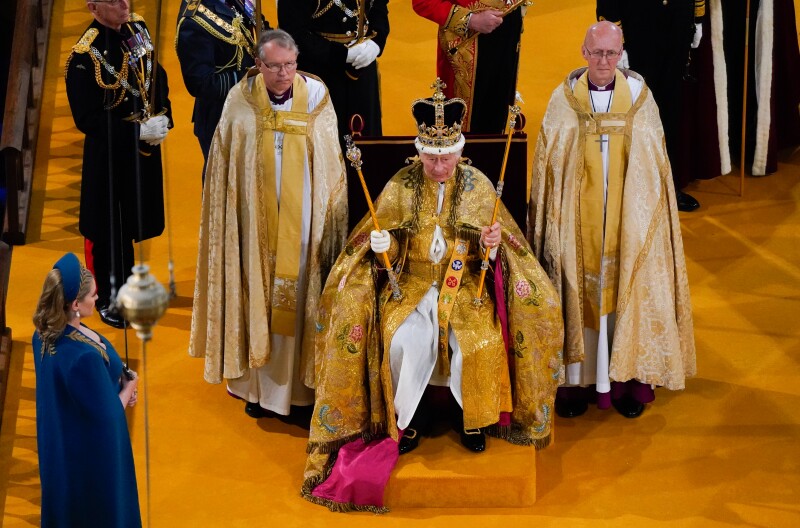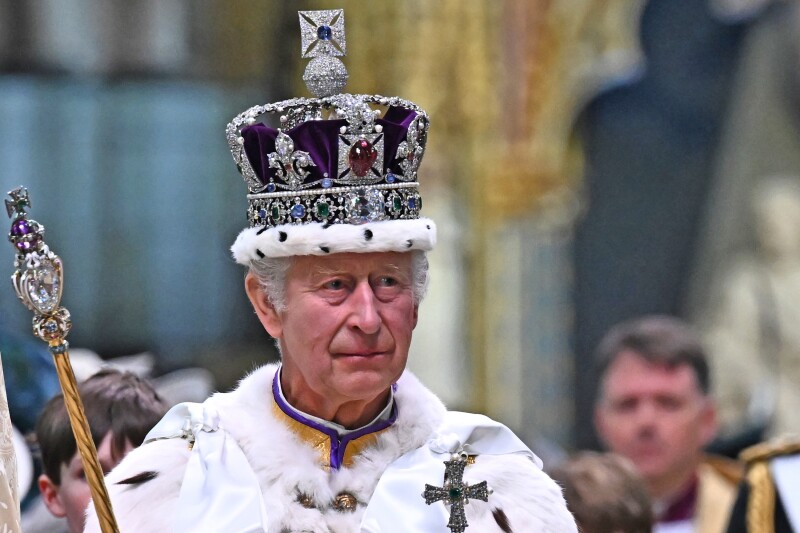Britain’s patriotic pride was on full display for the coronation of King Charles III on May 6, 2023. Banners and flags waved on every building and crowds packed the streets of London for a glimpse of the procession. Even from across the pond, there were plenty of American fans setting their alarms for the early morning hours to watch the historic event unfold in real time. But as fun as it is to revel in the pomp and pageantry of it all, there’s more to the ceremony than meets the eye—what many people may not fully realize is that the coronation is largely a religious ceremony that’s rich with scriptural symbolism.
Ever since the arrival of Christian monks to the British Isles in AD 597, Christianity has been the predominant religion of the region and monarchy. In AD1066, the Norman Conquest brought the formerly isolated Britain into closer contact with Latin Europe and the influence of the Roman Catholic church. But in the 16th century, the religious unrest of the Protestant Reformation and King Henry VIII’s pursuit of an annulled marriage resulted in the infamous separation of the Church of England from the Roman Catholic church. As part of that split, Parliament passed several official acts, including the Act of Supremacy which made the British monarch the supreme governor of the Church of England. Ever since then, the Church of England and the monarchy have been tightly intertwined.
A comparison between elements of the coronation and those principles can remind Latter-day Saints about the accessibility of gospel blessings.
In keeping with over 500 years of religious tradition, King Charles III’s coronation commemorated his new identity as head of the Church of England. Because of the ceremony’s religious and symbolic nature, Latter-day Saints may have noticed that the ceremony had several elements in common with familiar gospel principles. A comparison between elements of the coronation and those principles can remind Latter-day Saints about the accessibility of gospel blessings: the coronation was a one-time grand ceremony meant for just one man—but it highlighted three important principles that Latter-day Saints can access every day.
Anointing
The most sacred part of the English coronation ceremony is the anointing of the new monarch—this sacred moment symbolizes God’s blessing on the new monarch as head of the church. Because of the sacred nature of the anointing, a screen or canopy has historically been placed around King Edward’s ancient coronation chair to shield the anointing from view. The BBC reported that when Queen Elizabeth was crowned in 1953, a golden canopy was erected around the coronation for her anointing ceremony. For King Charles’s anointing, an embroidered screen was placed around the coronation chair.
The choir sang Handel’s Zadok the Priest while King Charles was anointed. Even though the clip above does not show the anointing, we do know that the Archbishop of Canterbury anointed the King’s hands, chest, and arms with consecrated oil from the Mount of Olives in Jerusalem. The exact words of King Charles’ anointing ceremony are unlikely to be published, but the BBC has reported that during the anointing blessing of Queen Elizabeth I the archbishop said, “Be thy head anointed with holy oil: as kings, priests, and prophets were anointed. … so be you anointed, blessed, and consecrated Queen over the Peoples, whom the Lord they God hath given thee to rule and govern.”
The Archbishop of Canterbury anointed the King’s hands, chest, and arms with consecrated oil from the Mount of Olives in Jerusalem.
The tradition of anointing religious leaders comes from the Old Testament. In 1 Kings, King David called Zadok the priest and Nathan the prophet to anoint him as a king over Israel. In Exodus, the Lord instructed Moses to anoint Aaron and his sons to “sanctify [them], that [they] may minister unto [the Lord] in the priest’s office.”
Many Latter-day Saints are familiar with ordinances that involve anointings, including the anointing of the sick and afflicted with consecrated oil. Worthy Melchizedek priesthood holders can anoint and bless the sick with consecrated oil. Like the oil used in the King’s anointing, priesthood holders only use consecrated olive oil for the anointing of the sick and afflicted. The act of blessing and healing the sick with consecrated oil comes from Jesus’s example in the New Testament. In Mark 6 we learn that Jesus “laid his hands upon a few sick folk, and healed them” and that his disciples also “anointed with oil many that were sick, and healed them.”
Clothing
Symbolic clothing plays an important role the coronation ceremony. Before being anointed, King Charles’s robes of state were removed, and he wore a simple white tunic that represents humility and purity before God.

After the anointing, King Charles was given new symbolic clothing to wear—this part of the ceremony is called the Investiture. The King was first invested, or clothed, with the colobium sidonis—a white linen shift-like tunic that represents a priest’s alb, or liturgical vestment. Next, the King was clothed in a priestly robe called the supertunica—a full-length, Byzantine-inspired gold coat. The supertunica was then fastened with a girdle (also called the coronation sword belt). And last, but not least, the King was invested with the Imperial Mantle—a gold cloak richly embroidered with symbols of the monarchy, church, and Commonwealth (Is anyone else thinking about how heavy that outfit must have been?). Collectively, the King’s ceremonial clothing reflects the clothing of priests and represents both his position as monarch and as the head of the Church of England.
In the scriptures, the color white is often symbolic of purity and righteousness. Similarly, religious clothing, like the King's white tunic, is often white to represent humility and purity before God. Latter-day Saints also wear white clothing for important ordinances like baptism—not only to represent humility and purity, but to represent the cleansing power of Christ and the remission of sin through His Atonement.
Religious clothing, like the King's white tunic, is often white to represent humility and purity before God.
Many religions have sacred, symbolic clothing—much like the King’s ceremonial clothing—that plays an important role in outwardly expressing devotion to God. Take, for example, the nun’s habit, the priest’s cassock, the Muslim’s skull cap, or even the temple garment and robes. Religious clothing is reflective of an inner commitment to Jesus Christ and is rooted in ancient priestly tradition.
When the Lord instructed Moses to prepare Aaron and his sons to become priests, sacred clothing was part of that preparation. In Exodus 40, the Lord says, “And thou shalt put upon Aaron the holy garments, and anoint him, and sanctify him; … And thou shalt bring his sons, and clothe them with coats.” Symbolic, religious clothing was necessary to prepare Aaron and his sons to become priests and leaders. It is natural, then, that important ceremonies and ordinances, within and without the church, reflect this scriptural tradition, teaching Latter-day Saints about their spiritual heritage and their divine potential.
Oaths and Covenants
Before he was anointed and crowned, King Charles knelt at an altar and promised to govern the territories and isles of the United Kingdom, rule with justice and mercy according to the law, live the gospel, and maintain the laws of God. The Encyclopedia Britannica says that the oath is the only component of the ceremony that is required by law, and the wording of the oath has varied over time to reflect the current state of the United Kingdom. But the purpose has always been the same—the sovereign must promise to uphold civil law and the laws of the Church of England. In short, the King’s oaths bonded him more closely with the Commonwealth and the Church of England.
Members of The Church of Jesus Christ of Latter-day Saints are familiar with the idea of making oaths, or covenants, with God. At baptism, Latter-day Saints demonstrate their willingness to follow the Savior’s example and covenant to take upon themselves His name, keep His commandments, and serve Him to the end. In the temple, members of the Church are invited to make several sacred covenants, including the Law of the Gospel, which is the higher law that Jesus taught while on earth, and the Law of Consecration.
▶ You may also like: What are the 5 covenants made in the temple endowment?
The Law of Consecration is a scriptural law and has been taught ever since the beginning of the Restoration; the Lord instructed Joseph Smith to teach the Saints to consecrate, or sacrifice, their property, time, and talents to the Church so that they could better support the poor and needy. For Latter-day Saints today, living the Law of Consecration could mean accepting a difficult church calling, making time to minister to a friend, studying Come Follow Me, paying a full tithe, or setting aside time to attend the temple.
What’s the connection between the Law of Consecration and King Charles’ coronation oath?
But what’s the connection between the Law of Consecration and King Charles’ coronation oath? The coronation oath reinforces the idea that King Charles has promised to dedicate his life to his nation and the Church of England. The Law of Consecration teaches something similar—it invites members to dedicate their lives completely to God and the building up of His kingdom.
Living the law of consecration is not a one-and-done endeavor—it is the result of a million different choices over the span of a lifetime and always for one purpose: dedicating our lives to God, just as a king might dedicate his life to his people. When we dedicate our lives to God, it gives Him the opportunity to mold and shape us.
Even though members of the Church are not responsible to lead an entire nation or church after making a covenant with God, they do promise to keep His commandments. Rather than being bonded to a nation, they become bonded more closely to God.
President Russel M. Nelson taught that “Making a covenant with God changes our relationship with Him forever. It blesses us with an extra measure of love and mercy. It affects who we are and how God will help us become what we can become.”
Latter-day Saints may consider themselves lucky, then, that they have access to God’s power and blessing regularly, and not just on special occasions. And perhaps this comparison might serve as a reminder of all the many blessings that are in store for us as we live our faith every day.


